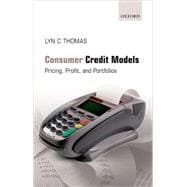
Note: Supplemental materials are not guaranteed with Rental or Used book purchases.
Purchase Benefits
What is included with this book?
| Acknowledgements | p. xiii |
| Introduction to consumer credit and credit scoring | p. 1 |
| Introduction: importance and impact of consumer credit | p. 1 |
| Historical background of default-based credit scoring | p. 5 |
| Objectives of lenders | p. 9 |
| Tools for modelling lending decisions: influence diagrams, decision trees, and strategy trees | p. 13 |
| Probabilities, odds, information, and scores | p. 25 |
| Modifying scores: scaling, multiple levels, and time dependency | p. 41 |
| Lending returns and costs | p. 53 |
| Fundamentals of scorecard building | p. 62 |
| Using logistic regression to build scorecards | p. 79 |
| Other scorecard-building approaches | p. 84 |
| Measurement of scoring systems | p. 100 |
| Measuring scorecard quality | p. 100 |
| Discrimination measures: divergence, Kolmogorov-Smirnov statistic, and D-concordance statistic | p. 104 |
| ROC curve and Gini coefficient | p. 115 |
| Scorecard segmentation and measuring its impact on discrimination | p. 128 |
| Calibration measures of scorecard probability predictions | p. 137 |
| Measures of the correctness of categorical prediction | p. 146 |
| Risk-based pricing | p. 152 |
| Variable pricing in consumer lending | p. 152 |
| Risk-free response rate function and optimal pricing | p. 152 |
| Risk response relationship, adverse selection, and affordability | p. 169 |
| Risk-based response function and risk-based pricing | p. 175 |
| Acceptance scoring for multi-feature offers | p. 186 |
| A borrower-lender game model for pricing | p. 196 |
| Profit scoring and dynamic models | p. 204 |
| Behavioural scoring and dynamic account management | p. 204 |
| Profit scoring, risk/reward matrices to customer behaviour dynamics | p. 212 |
| Markov chain models of account behaviour | p. 220 |
| Markov decision process models of profitability | p. 237 |
| Survival analysis-based scoring systems and default estimation | p. 251 |
| Survival analysis-based profit models, including attrition and prepayment | p. 269 |
| Portfolio credit risk and the Basel Accord | p. 278 |
| Portfolio credit risk | p. 278 |
| Economic and regulatory capital | p. 286 |
| Summary of Basel Capital Accords | p. 289 |
| Basel II regulations and their impact on credit scoring | p. 303 |
| Regulatory capital and optimal cut-off policies | p. 314 |
| Modelling credit risk for portfolios of consumer and corporate loans | p. 330 |
| Basel stress testing of consumer portfolios: static and dynamic approaches | p. 347 |
| Appendices | p. 360 |
| Scores and runbook example | p. 360 |
| Southampton bank application data | p. 362 |
| References | p. 365 |
| Index | p. 371 |
| Table of Contents provided by Ingram. All Rights Reserved. |
The New copy of this book will include any supplemental materials advertised. Please check the title of the book to determine if it should include any access cards, study guides, lab manuals, CDs, etc.
The Used, Rental and eBook copies of this book are not guaranteed to include any supplemental materials. Typically, only the book itself is included. This is true even if the title states it includes any access cards, study guides, lab manuals, CDs, etc.